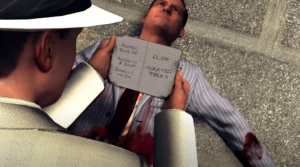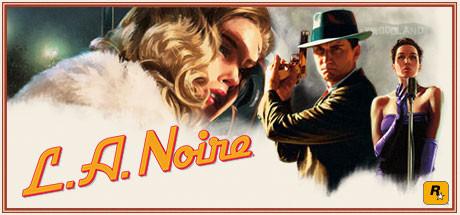In the 1940s, Hollywood was not as it is today. In fact, it wasn’t even called Hollywood (Hollywoodland). Set in post World War II Los Angeles, LA Noire, published by Rockstar Games (Grand Theft Auto, Red Dead Redemption, etc), is a gritty, grimy mystery/thriller that enthralls the player in the secretive, dirty town of Los Angeles in the 1940s. I played LA Noire on PS4. This game is meant for a mature audience (as suggested by its rating “M”) that enjoys narrative mystery/thriller games with less emphasis on combat.
Overall, I loved playing LA Noire. I’m a fan of all of Rockstar’s stuff so it was cool to go back and play one of their earlier games that I had heard so much about but never played (I can really see where some mechanics of GTA and RDR come from). After playing for a few hours, two formal elements stood out to me: boundaries and objectives. This is an open world game, so the player has freedom in choosing how fast they navigate the story. This was pretty fun and interesting, but was pretty distracting for someone like me who loves exploring every part of the map. Oftentimes, I’d get sidetracked and forget the mission I was supposed to go towards just to check out LA in the 1940s. In this case, the boundaries are really loose and the player can choose when to make their “magic circle” smaller or larger, depending on how fast they want to complete the main story. The other element, objective, was also very prominent in my playthrough. This is a mystery game, so, of course, solving mysteries and murders in LA is the main task of the game. That’s also how “fun” was created on my playthrough. I loved uncovering more info on cases by talking and interviewing NPCs, uncovering certain clues, and investigating crime scenes. I felt like I was playing a video game version of Chinatown, the Jack Nicholson movie set in the same time period, during my playthrough, which I think is awesome. This game does a great job at drip feeding you the perfect amount of info that keeps you wanting to pursue these crime cases. If I could change something, it would have to be the actual action/combat parts of the game. I wish the remastered version I was playing did a better job with improving the actual combat. It felt sticky and pretty unrealistic, even with the 13 years since its original release they’ve had to make it more fluid.
LA Noire does a great job at weaving in different forms of narrative elements into this gray, almost dystopian version of LA that the player interacts with. Embedded narrative is very present. There are multiple ways the player can approach each crime scene. Players can choose to interact with any crime scene in any way they want. For example, they can pick up the newspaper clipping and read it first, and then uncover the hidden weapon, or vice versa. However, the fact that person X still committed the crime won’t change. This makes sense though because this is exactly how it works with real crimes and crime scenes. Different detectives will uncover different pieces of evidence at different times, and that doesn’t change the fact that person X still did the crime. Having embedded narrative be the most prominent form of narrative in LA Noire is fitting, and really suits the genre well here. The game’s mechanics support this type of embedded narrative. In LA Noire, players use a notebook to keep track of all evidence, objectives, motives, and locations. This is a great way to keep the player engaged in the story and narrative of the game while also implementing something really tricky in game design: objective reminders. Oftentimes, objective reminders (like bright yellow arrow pings on maps, etc) can be intrusive and take the player out of the narrative. In LA Noire, you play as a detective, and just as a real detective would use a notebook to keep track of clues and objectives, so do you. I loved this about LA Noire and thought it was one of the strongest parts of the game narrative wise.






